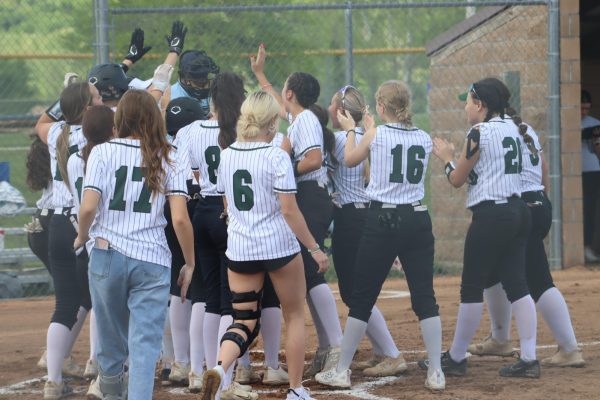Students take advantage of free college credit
Juniors Logan Struck and Seth Huffman, work on online classes in the library media room. Both Strunck and Huffman have taken dual credit classes during fall semester.
High school students can now take some dual credit classes for free.
Starting in spring semester 2020, State Fair Community College Board of Trustees are offering a new opportunity for free tuition for high school students taking dual credit classes. They are following the lead of other schools around Missouri.
“This all started last summer. Missouri State started offering free tuition to student., State Fair caught wind of it and they said that they were going to do that as well. So that was passed this last fall, going into effect for this spring semester, 2020. They’re still kind of learning how it’s all gonna go,” High school counselor Tyler Richardson said.
Colleges are trying to give a helping hand to students from districts with high free and reduced lunch populations.
“Studies have shown that high school students who earn college credits before graduating are more likely to complete high school, go on to college and earn degrees,” said Dr. Joanna Anderson, SFCC president on the SFCC website. “This tuition-free dual credit program will remove the financial barrier for high school students from low-income families.”
Also this free dual credit program will help poverty level students who want to pursue college, a chance to get some of those credits for free.
“Without adequate education, young people are relegated to low-paying, unskilled service jobs that fail to provide economic security and trap them in a lifetime of poverty,” according to Missouri Community Action Network.
“SFCCMO. Edu, cited research from Missouri Department of Elementary and Secondary Education that claims 48.98 percent of students around the state qualify for the Lunch Program, this means those students who are doing dual credit are allowed to 12 hours of free college classes.
“I believe State Fair students can take up to 12 hours for free as long as they are on free and reduced lunch. Our school is on the Community Eligibility program or CP. So, according to the state, every one of our students qualify for free and reduced lunch,” Richardson said.
With this opportunity for dual credit students, there are different benefits that are offered depending on what type of school they are going to.
“So our students that go to State Fair, get free tuition up to 12 hours. Missouri State students that are taking Dual Credit through Missouri State, they get free tuition up to six hours or basically two full three-hour classes,” Richardson said.
Junior Taylor Spry takes advantage of some free dual credit classes, although others she still must pay for.
“It’s really nice because I also take my math classes through dual credit and they’re through CMU, so they still cost money and it sucks,” Spry said.
Applying for this free program is simple when students are first applying for their classes at the beginning of the year, but there are some guidelines for being eligible. Students must have a 2.5 GPA to qualify to take a dual credit class.
“There’s no application, so you just go through your general enrollment for classes, and then on the enrollment form there is a place for me to check whether they are free and reduced, and then I have to verify with my initials,” Richardson said.
As students are applying for this program, they need to understand what classes will be work for them for the best results in the future. Richardson claims that this program has many advantages towards students that want to go above and beyond high school.
“So first of all, it helps students get through college faster, that’s one advantage. Another advantage because now it’s free tuition those are classes that you may not have to pay for down the road,” Richardson said.
“I think it is super helpful for a school district like ours. It opens up college credit opportunities for students who could not afford the costs before. I believe that it allows students to get a head start on college itself, such as course load and time management,” Senior Jessica Dwyer said.
Richardson warns of negative consequences of students taking dual credit classes and not being ready for that level of academic rigor.
“You take a junior, for instance, or even a sophomore that takes a dual credit college class, they are somewhere between 15 and 18 years old. And you look at a college student that’s usually going to be somewhere between 18 and 24 years old, there’s a lot of maturity that has to have to take place there,” Richardson said.
“The negative of this is, an dual credit student fails class and then goes on their permanent college transcript. And when they transfer to another college, if they have “F”, then then they’ve got a problem. So once you do that, and then that’s part of your permanent record, Richardson added.

Senior PetralieJo Wurtz has not just an interesting name, but an interesting life story. Adopted when he was two years old, Wurtz left his orphanage...










